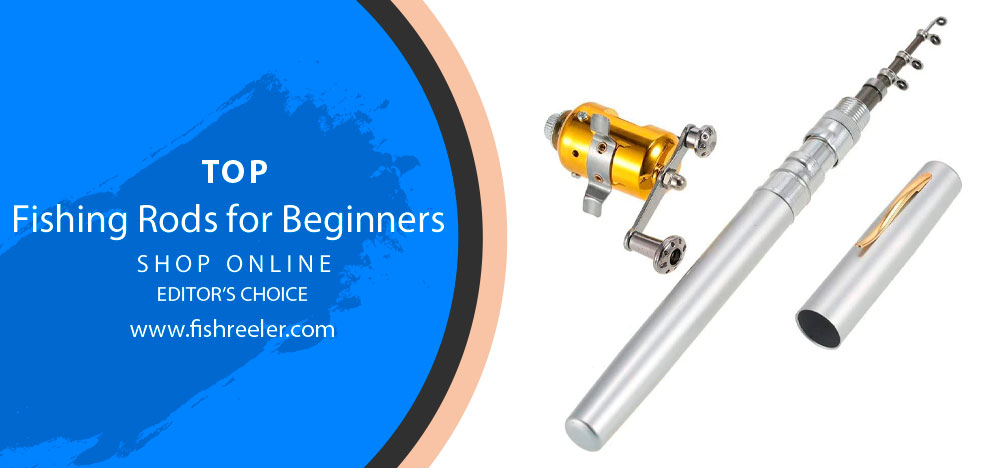
🎣 The First Step to Fishing Success: Choosing Your Rod! 🎣
So, you’ve decided to embark on the timeless adventure of fishing! 🐟✨ First off, welcome to a world that combines patience, skill, and a touch of luck. But before you can cast your first line and reel in those memorable catches, there’s a crucial step: selecting the right fishing rod.
🔍 Why is this so important?
✅ Confidence Boost: A rod suited to your needs can make a world of difference. It can enhance your confidence, ensuring that your first experience is nothing short of fantastic.
✅ Avoid Over-spending: Without guidance, it’s easy to overspend on gear that might not be the best fit for beginners.
✅ Optimal Experience: Choosing the right rod means a better balance, feel, and overall fishing experience. No more struggling with too long, too heavy, or too complicated gear!
Ready to dive deeper? Let’s ensure your fishing journey starts with the best footing (or should we say, fishing) possible! 🌊
🎣 Your First Fishing Rod and Its Importance 🎣

When it comes to fishing, your first rod is not just a tool – it’s the start of an adventure, a story yet to unfold, and the bridge that connects you to the vast, mysterious world beneath the water’s surface. Every angler remembers their first fishing rod: the weight in their hands, the shimmer of the reel, and that exhilarating moment of the first cast. 🌊
Whether you’re fishing to find tranquility, challenge, or simply a fresh meal, the rod you start with can set the tone for every following experience. This is why it’s crucial to make an informed and thoughtful choice.
In this guide, we’ll delve into the intricate world of fishing rods for beginners. From understanding the very basics that shape the art of angling to uncovering the technical aspects of a rod, we aim to equip you with all you need. By the end, you’ll not only recognize the importance of that first rod but also feel confident in making a selection that complements your budding fishing journey. 🛶🐟
🐠 Understanding Fishing Basics: Dive into the Depths! 🐠

🌿 Why Start Fishing?
Fishing isn’t just about catching fish; it’s a holistic experience that brings numerous rewards to those who pursue it. Let’s uncover the reasons why so many people are captivated by this age-old activity.
Physical Benefits:
💦 Exercise and Coordination: Casting a line, reeling in a catch, and even the simple act of holding your rod steady engages various muscle groups. Plus, with each trip, you refine your motor skills and hand-eye coordination. 🏋️♂️🎣
Mental Benefits:
🐋 Patience: Waiting for that bite teaches you the essence of patience, a virtue in today’s fast-paced world.
🐋 Relaxation: The rhythmic sound of lapping water, the gentle sway of your boat, and the occasional chirping of birds offer a tranquil escape from daily stresses.
🐋 Connection with Nature: Amidst nature, you develop a profound bond with the environment, understanding its rhythms and intricacies. 🍃🧠
Social Benefits:
🐳 Bonding Time: Fishing is an excellent way to spend quality moments with loved ones. Whether it’s a father-son bonding session or a friendly competition among pals, the memories created are priceless. 👨👧👦❤️
🌊 Different Types of Fishing: Know Your Waters! 🌊

The type of fishing you choose can greatly influence the rod you need. Let’s dive into the primary fishing methods and understand their unique demands.
Freshwater vs. Saltwater:
🌊 Freshwater Fishing: Done in rivers, lakes, and ponds. The fish are usually smaller, requiring a lighter and more flexible rod.
🌊 Saltwater Fishing: Practiced in oceans and seas, targeting larger species. Demands sturdier rods that can resist corrosion from salty water.
Specific Fishing Types:
🐬 Fly Fishing: Using artificial flies as lures, this technique requires specially designed rods that are lightweight and flexible. Ideal for catching trout or salmon in rivers.
🐬 Trolling: Fishing by dragging a lure behind a moving boat. The rods are robust, with a strong backbone to handle bigger fish.
🐬 Surf Fishing: Casting from the shoreline into the ocean. Long rods are used to achieve greater casting distance, essential for reaching distant schools of fish.
The type of fishing not only dictates the kind of rod you’ll need but also shapes your overall experience. From tranquil freshwater locales to the vast expanse of the sea, each fishing type offers a unique adventure. 🚤🏞️
Choosing the right method and understanding its demands ensures a rewarding fishing experience. As you venture further, you’ll realize that your rod is an extension of your passion, evolving with your skills and preferences. 🌌
🔍 Key Components of a Fishing Rod: Crafting the Perfect Catch! 🔍

Understanding the anatomy of a fishing rod is imperative for every budding angler. Each part plays a distinct role in your fishing expedition, influencing the ease of use, performance, and the catch itself. Let’s break down these elements to ensure you’re well-equipped for your aquatic adventures.
🌐 The Rod Blank: Building the Backbone
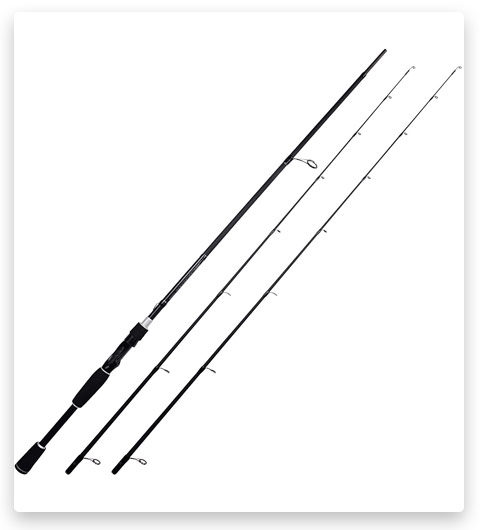
The rod blank is the primary body of your fishing rod. Its material largely determines its responsiveness, flexibility, and strength.
Fiberglass:
- Characteristics: Durable and flexible.
- Performance: Offers a slower action, ideal for beginners because of its forgiving nature.
Graphite:
- Characteristics: Lighter than fiberglass and highly sensitive.
- Performance: Offers faster action, allowing more precision but requires a defter touch.
Composite (Blend of Fiberglass and Graphite):
- Characteristics: Balances the properties of both materials.
- Performance: Offers a medium to fast action, providing both sensitivity and durability.
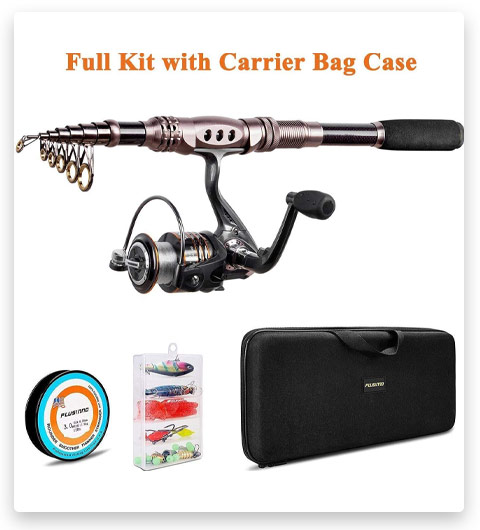
⚖️ Action & Power: The Heart and Soul of Your Rod
These two terms frequently pop up when discussing fishing rods. Understanding them is key to mastering the art of angling.
Action:
- Definition: Refers to where the rod bends.
- Types: Fast (bends near the tip), Medium (middle bend), Slow (bends closer to the base).
Importance: Dictates the rod’s sensitivity and how quickly it returns to its neutral position.
Power:
- Definition: Refers to the rod’s resistance to bending.
- Types: Light, Medium, Heavy.
- Choosing Right: Target larger fish with heavier power rods and smaller fish with lighter power rods.
➰ Butt for Rod
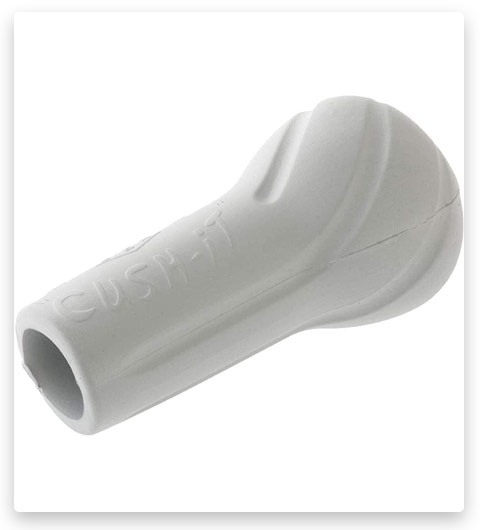
One crucial component of any fishing rod is the butt. While often overlooked, the butt of a fishing rod can significantly impact the overall performance of your rod. The butt of a fishing rod serves as the handle, providing you with a comfortable grip while you fish. One of the biggest strengths of a good butt is its ability to reduce hand and arm fatigue, allowing you to fish for longer periods without discomfort.
Additionally, the butt of a fishing rod can significantly impact its sensitivity, providing you with better control and feedback when reeling in your catch. A well-designed butt can also help distribute the rod’s weight more evenly, making it easier to balance and reducing the strain on your wrist.
The butt is a cap that is located at the bottom of the handle. You will need it for several purposes. They depend on the type of rod. But its main goal is to help in the fight against large fish. You press it against your stomach and it gives you more leverage. The cap can be made of rubber or cork.
🤝 Handle & Grip: Holding Onto Success
The handle is where you’ll be gripping the rod, so comfort is paramount.
Materials:
- Cork: Lightweight, easy to grip, and provides a traditional look.
- EVA Foam: Durable, resistant to water damage, and offers a soft touch.
Importance: A comfortable grip can mean the difference between enjoying hours on the water and packing up early due to hand fatigue.
🔄 Reel Seat: The Rod’s Powerhouse
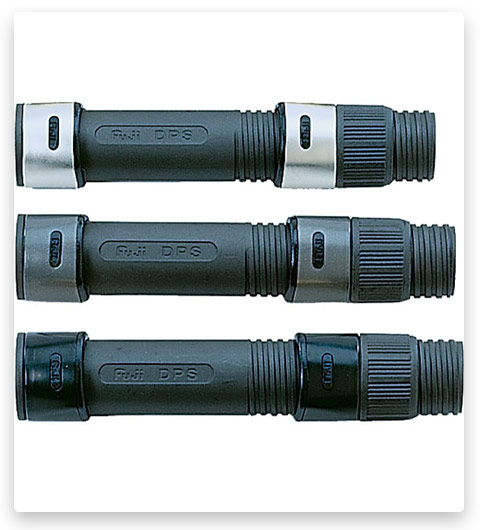
This component holds the reel in place, forming the operational base for casting and reeling.
Importance: Ensure compatibility between the reel seat and your chosen reel. A secure fit boosts performance and minimizes equipment malfunctions.
🧵 Guides & Line: Steering Your Catch
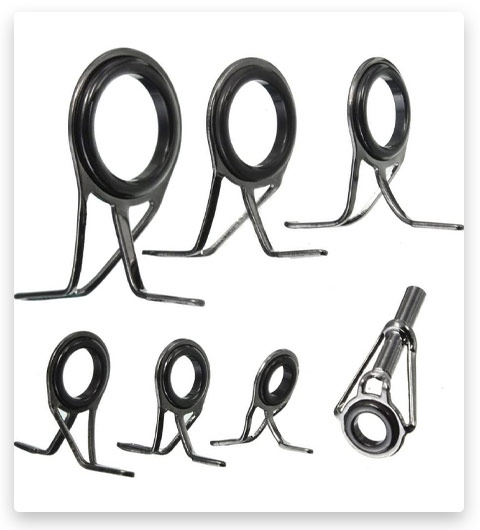
Guides are the circular attachments that run down the rod, directing the line.
- Influence: The quality and placement of guides determine casting distance and accuracy.
- Line: Your choice of line (monofilament, braided, fluorocarbon) works in tandem with the guides. Ensure the line’s weight and type are suited to the rod’s specifications for optimal performance.
I have some advice for you. If you don’t want to spoil the guide and loosen the fishing line, then never put a hook on it. Choose ceramic rings. Your fishing rod is more than a tool; it’s a synergy of meticulously crafted components, each playing its part in your angling story. 🐟
💍 Hook Keeper
How important it is to keep your hooks safe and secure when not in use. That’s where the hook keeper comes in. A hook keeper is a small device attached to the fishing rod that allows you to store your hooks safely and conveniently.
It’s a simple but essential tool that can help prevent accidents, tangles, and damage to your fishing gear. But with so many types of hook keepers available, how do you choose the best one for your needs? In this guide, we’ll explore the key features of hook keepers, including their materials, installation methods, and placement on the fishing rod.
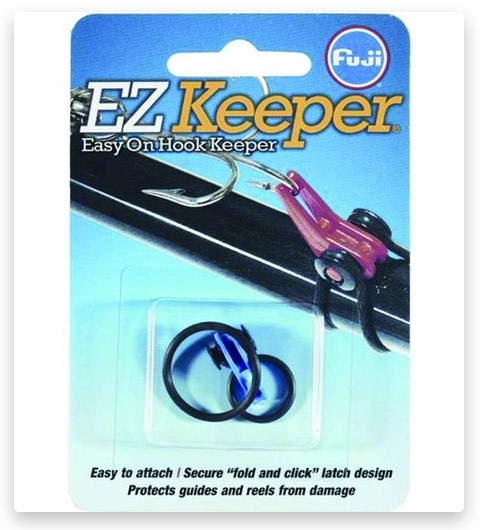
🤔 Factors to Consider When Choosing Your First Rod 🎣
Selecting your first fishing rod is akin to a rite of passage in the angling community. It’s the first step to creating countless memories, whether they’re of triumphant catches or the serene peace of waiting by the waterside. But with so many options, how do you narrow down the perfect rod for you? Let’s dissect the primary considerations.
💸 Your Budget: Striking the Right Balance
Fishing rods come in a spectrum of prices, but it’s essential to remember: more expensive doesn’t always mean better, especially for beginners.
- Finding Value: Seek rods that offer the best quality within your budget range. Brands with a strong reputation in the fishing community are often a good starting point.
- Invest Smartly: As a beginner, you don’t need the highest-end rod. Opt for something durable and user-friendly to hone your skills.
🐟 Targeted Fish Species: Aim with Precision
Each fish species presents its unique challenges, and your rod should be equipped to tackle them.
- Small Species (e.g., panfish, small trout): Light to medium power rods.
- Medium Species (e.g., bass, catfish): Medium to medium-heavy rods.
- Large Species (e.g., salmon, muskie): Heavy power rods with a longer length.
🌍 Fishing Location: Adapting to Your Surroundings
The waters you fish in can drastically affect the type of rod you need.
- Ponds/Lakes: Typically calm waters, suitable for lighter rods.
- Rivers/Streams: Moving water demands a sturdier rod, especially if currents are strong.
- Ocean: Requires heavy-duty rods, especially if you’re fishing from a beach or off a boat in deep waters.
⏳ Duration of Fishing Sessions: Ensuring Comfort
If you’re someone who envisions long, uninterrupted sessions by the water, your rod’s comfort factor is non-negotiable.
- Weight: Opt for a lightweight rod that won’t strain your arms over extended periods.
- Grip: As discussed earlier, the handle’s material and design can affect comfort. Choose what feels right in your hands.
🎒 Storage & Portability: On-the-Go Solutions
Especially for those with wanderlust, the ease of transporting your rod can make all the difference.
- Telescopic Rods: These rods collapse down, making them incredibly portable. They’re great for backpacking trips or when space is at a premium.
- Traditional Rods: Often come in one or two pieces and provide a classic fishing experience. While less portable, they tend to be sturdier.
- Rod Case Importance: No matter your rod type, always invest in a protective case. It ensures your rod’s longevity and shields it from accidental damage. 🌅🐠
From Freshwater to Saltwater: Choosing the Right Fishing Rod for Your Needs
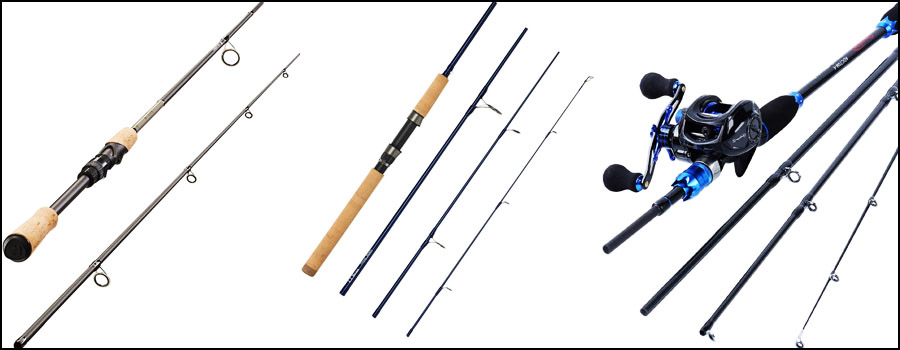
Choosing the right fishing rod is essential to your success on the water. But with so many types of fishing rods on the market, it can be challenging to know which one to choose. From spinning rods and casting rods to fly rods and surf rods, each type of fishing rod has its own unique features and benefits. In this guide, we’ll explore the different types of fishing rods and discuss the situations where each type excels.
Casting Call: Understanding Rod Length, Power, and Action
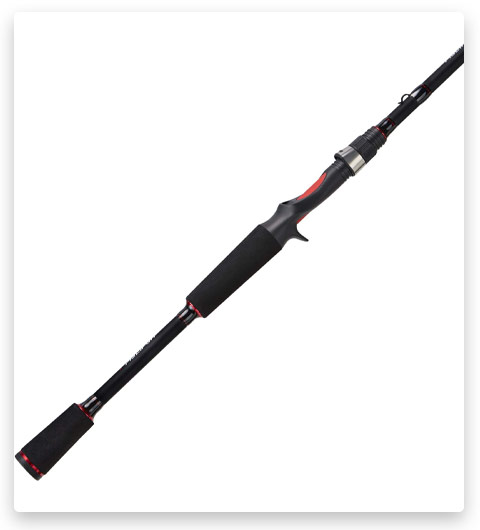
This type of fishing rod can make accurate casts. You can change the casts from the top and thus achieve long distances. It has a finger stop in the place where the reel is attached for fishing and casting. To cast, you need to hold the fishing rod rings up. This fishing rod has many rings and they are often located and don’t confuse. There is no inertia when casting. It stops itself when casting. You will not encounter the problem of tangling the fishing line. Good materials are used and therefore it is more expensive.
Spinning Rods
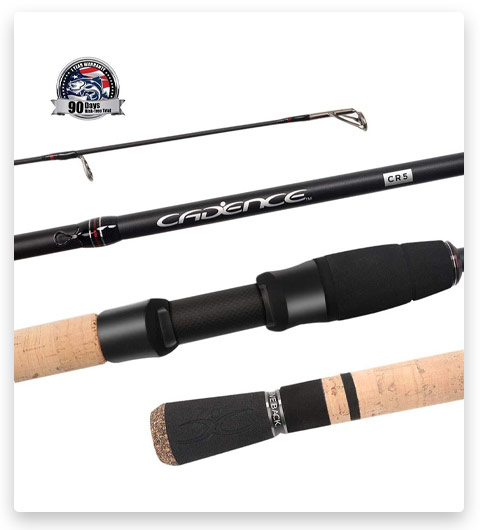
This type of pole is the most affordable, it is easy to use and is appreciated by most beginners. You can make long throws. And the lures should be light. The reel is attached to the bottom of the fishing rod. It has a large guide ring that is close to the reel. During casting, the friction on the fishing line is reduced. This is the basic type of fishing rod. It is better to look for fiberglass fishing rods.
Fly Rods
A fly rod is a specialized type of fishing rod that is designed for use in fly fishing. Unlike traditional fishing rods, which use lures or bait to attract fish, fly fishing relies on the use of a lightweight artificial fly that is cast with the fly rod and line.
Fly rods are typically longer and more flexible than other types of fishing rods, and are designed to help the angler accurately and delicately cast the fly to the desired location. They are also typically made from lightweight materials such as graphite, fiberglass, or bamboo to help reduce fatigue during long periods of casting.
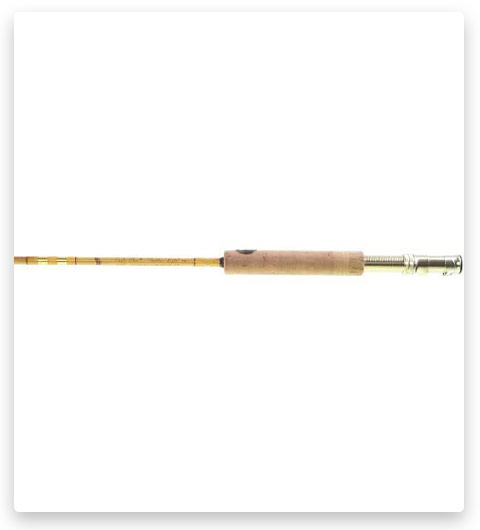
Ocean Fishing Rods
An ocean fishing rod is a type of fishing rod that is designed for use in saltwater fishing, which typically involves targeting larger and stronger fish species found in the open ocean. Ocean fishing rods are typically longer and more powerful than other types of fishing rods, with the ability to handle heavier lines and lures or bait.
Ocean fishing rods can be classified into different categories based on their intended use, such as trolling rods, spinning rods, jigging rods, and surfcasting rods:
- Trolling rods are designed for use with trolling reels, and are used to drag lures or bait behind a moving boat.
- Spinning rods are used with spinning reels and are ideal for casting lighter lures or bait into the surf or around rocky shorelines.
- Jigging rods are designed for vertical fishing techniques, and are typically shorter and more powerful to help anglers jig heavier lures or bait off the ocean floor.
- Surfcasting rods are the longest of all ocean fishing rods, and are designed for casting long distances from the shore.
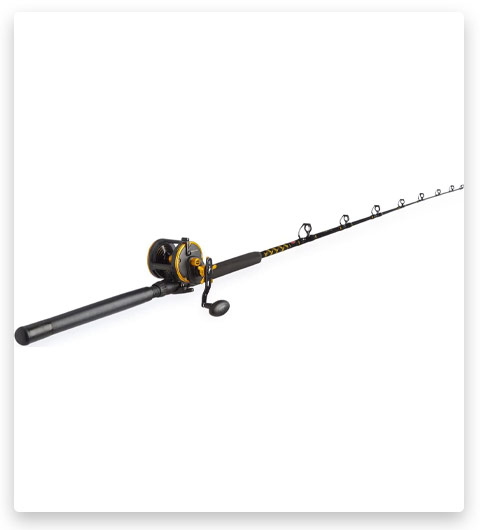
This is the type of fishing rod that you can use to catch a huge fish in the ocean. They are short and long. Choose a short one for fishing from a boat and a long one for fishing from the shore. This rod is heavy and has a long butt. To process a thick fishing line, this rod has large guide rings.
Trolling Rods
A trolling rod is a type of fishing rod that is designed for use in trolling, which is a fishing technique that involves dragging lures or bait behind a moving boat in order to attract fish. Trolling rods are typically long and sturdy, with the ability to handle heavier lines and lures.
Trolling rods come in different lengths and styles, with some being specifically designed for use with downriggers or planers, which are devices that help to control the depth of the lure or bait. Trolling rods may also feature specialized guides and reel seats that are designed to handle the stresses of trolling, which can include constant pressure from the boat’s movement and the weight of the fish being caught.
Trolling is a popular fishing technique for targeting species such as salmon, trout, walleye, and tuna. Choosing the right trolling rod will depend on factors such as the target fish species, the size and weight of the lures being used, and the angler’s individual preferences and skill level.

Telescopic Rods For Fishing
A telescopic rod for fishing is a type of fishing rod that can be collapsed and extended to different lengths using a series of nested, hollow sections. This makes them ideal for traveling or when storage space is limited, as they can be easily carried in a backpack or luggage.
Telescopic rods for fishing are available in a range of lengths and styles, and can be used for a variety of fishing techniques, including spinning, baitcasting, and fly fishing. They are typically made from lightweight materials such as graphite or carbon fiber, which provides strength and sensitivity while keeping the weight of the rod to a minimum.
In general, this rod is almost the same as the spinning one. Its difference is in its convenient transportation. Since the rod is pulled out of the handle. When you don’t use it, you can fold it back. This saves you space. The telescopic fishing rod has a flexible tip. It has fewer guide rings. There are models without rings.
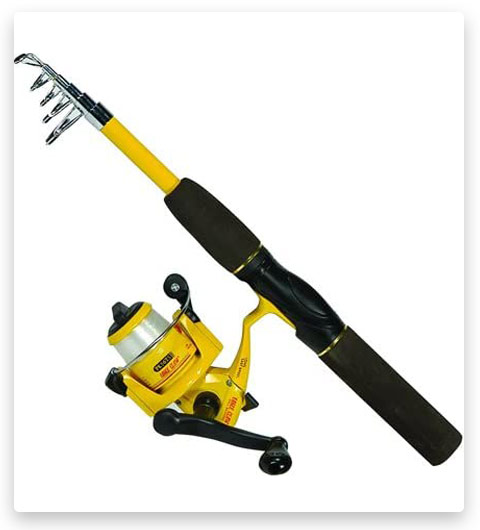
Then the fishing line moves through the center of the rod. It’s long. When you pull it out of the handle, the length can reach up to 20 pounds. More information can be found in this review – Best Telescopic Fishing Rod.
Pen Rods
A pen rod is a type of fishing rod that is designed to be compact and portable, resembling a pen or pencil when collapsed. They are ideal for anglers who need a fishing rod that can be easily carried in a pocket, backpack, or purse.
Pen rods typically consist of several nested sections that can be extended to form a functional fishing rod. They are typically made from lightweight materials such as aluminum or carbon fiber, which helps to keep the weight of the rod to a minimum.
The most compact fishing rod is this type. You can even carry it in your pocket. They are lightweight and the length comes to a few pounds. If you pick up a powerful reel and a strong fishing line, then this fishing rod will be good in its business.
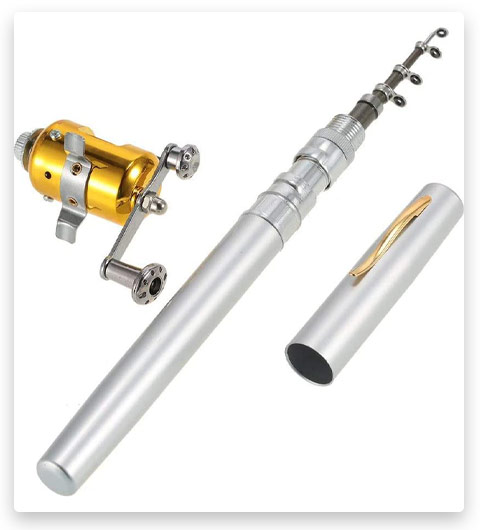
You can always carry it with you and if you get a chance to go fishing, you will have this opportunity. More information can be found in this review – Best Pen Fishing Rod.
Ice Fishing Rods
An ice fishing rod is a type of fishing rod designed specifically for use when fishing through a hole in the ice. It is generally shorter than traditional fishing rods and is designed to be held close to the body while fishing.
Ice fishing rods are often made of lightweight materials such as graphite or fiberglass, which makes them easier to handle in cold weather conditions. They also typically have a smaller diameter than traditional fishing rods to allow for greater sensitivity and control when fishing in shallow or deep water.
Ice fishing rods are often paired with a variety of different types of fishing reels, including spinning reels, baitcasting reels, and fly reels. The type of reel used depends on the type of fish being targeted and the fishing conditions.

This type of fishing rod resembles a spinning rod, but it is shorter in length. And the number of guide rings is also less than that of spinning rods. And their main feature is that you don’t need to use a reel. It has two hooks. One is attached to a fishing rod, and the other is thrown under the ice. The line must be wound manually. More information can be found in this review – Best Ice Fishing Rods.
Reel Choice
The reel is an important thing that determines the choice of a fishing rod. There are spinning and casting reels. Each type is intended for a specific purpose. A spinning reel is what you need if you are a novice fisherman. You will need less control over such a reel. Such coils don’t tend to get tangled. In rare cases. Light lures and baits are perfect for such reels. Casting reels, on the contrary, need more control than spinning reels. Therefore, they are difficult for beginners. And fishermen use them with heavy lures more often than with light ones.
Fishing Line Choice
A fishing line is a thin, flexible string or cord that is used to attach a bait or lure to a fishing rod and reel, and to catch fish. Fishing lines are typically made from a variety of materials, including monofilament, braided, or fluorocarbon fibers.
The fishing line is attached to the reel. It ends with bait or hook. The choice of fishing line should be approached as responsibly as the choice of fishing rods. They are made of different materials. Beginners should choose monofilament. This material is the most common and such a fishing line can be found in different colors. When choosing, pay attention to parameters such as strength, color, and size, and read the characteristics of your reel. Usually, it says what kind of fishing line it can handle.
🚫 Common Beginner Mistakes and How to Avoid Them 🎣

Embarking on your fishing journey is exhilarating, but as with any new venture, there’s potential for missteps. Beginners often get swayed by various factors, leading to common pitfalls. Here’s a guide to sidestepping those errors, ensuring your maiden voyage into the world of fishing is as smooth as the waters on a calm day.
💰 Overspending on High-End Gear Too Soon:
It’s tempting to think that spending big will immediately translate to big catches. But remember, fishing is as much about skill as it is about equipment.
- High-end gear can be complicated and might not be user-friendly for novices.
- Start with a moderate budget. Get a feel for the sport before deciding if those top-tier investments are worth it.
📏 Ignoring the Importance of Rod Length:
Size matters! A rod that’s too short or too long can affect casting accuracy and the types of fish you can catch.
- The wrong rod length can hamper your casting technique, limit where you can fish, and even strain your arms.
- Research! If you’re targeting small fish in narrow streams, shorter rods might be best. For casting longer distances in bigger waters, go for a longer rod.
🔗 Buying a Rod Without Considering Reel Compatibility:
Your rod and reel are a team. If one doesn’t match the other, your fishing experience can be less than optimal.
- A mismatched rod and reel can lead to poor balance, reduced casting accuracy, and even potential damage to your gear.
- Before purchasing, ensure the reel seat on the rod is compatible with your chosen reel type. If in doubt, ask experts or consider buying rod and reel combos designed to work together.
✋ Neglecting the Importance of Testing the Rod’s Feel in Person:
Online shopping is convenient, but when it comes to fishing rods, there’s no substitute for the tactile experience.
- Everyone’s comfort level is different. A rod might look perfect online but feel wrong in hand.
- Visit a local fishing or sporting goods store. Hold different rods, get a feel for their weight, balance, and grip. It’s a personal decision, and what feels right to someone else might not feel right to you. 🌊🐟
🌟 Recommendations: Gear Up for Your Fishing Adventure! 🎣
Here are top recommendations to kickstart your fishing journey.
🎖️ Top 3 Fishing Rods for Beginners:
FisherJoy Starter Rod:
AquaBegin Balance Rod:
NovoFisher Essential:
🎒 Must-Have Accessories for First-timers:
Protective Case: Safeguard your rod from physical damage during transport and storage. Consider cases with padding and adjustable straps for added convenience.
Cleaning Kits: Maintain your rod’s performance and longevity. Look for kits that include brushes, cleaning solutions, and lubricants tailored for fishing equipment.
Line Cutter: A small, portable tool to easily cut fishing lines, making changes or adjustments hassle-free.
Hook Keeper: An attachment for your rod that holds the hook when not in use, preventing potential injuries or tangles.
Fishing Hat & Sunglasses: Protect yourself from the sun and enhance visibility, ensuring a comfortable fishing experience. 🚣♂️🐠
🌠 Final Tips & Tricks: Finishing Your Fishing Primer with a Splash! 🎣
As you stand on the cusp of your fishing adventure, armed with knowledge and gear, there are some final pearls of wisdom to keep in mind. These are the intangibles – the little things that can make your fishing journey truly memorable.
🤝 Join a Local Angler Community or Group
Why it’s Beneficial:
- Shared Wisdom: Fishing is an art passed down through generations. By connecting with experienced anglers, you gain access to a treasure trove of insights and secrets.
- Mentorship: Benefit from hands-on guidance, where seasoned fishermen can provide on-the-spot tips and corrections.
- Friendship: Bond over shared experiences, create memories, and perhaps find lifelong fishing buddies.
🔄 The Value of Practicing Your Casting Technique
Perfecting the Art:
- Consistency: Just like any skill, the more you practice casting, the more consistent you’ll become. Over time, you’ll find yourself hitting your desired spot more often than not.
- Adaptability: Different fishing conditions might require varied casting techniques. With practice, you can adjust on the fly, ensuring you’re always ready.
- Confidence: A smooth cast can boost your confidence, making the fishing experience even more enjoyable.
🌅 Embrace the Experience
Fishing isn’t just about the thrill of the catch. It’s about the chirping birds, the ripple of the water, the cool breeze on your face, and the quiet moments of reflection.
- Moments Over Trophies: While landing a big fish is exhilarating, cherish the peaceful moments. The sunrises, the sound of nature, and the simple joy of being outdoors.
- Patience is Key: Some days might not yield a catch, but they still offer an experience. Embrace it, learn from it, and remember – every day on the water is a good day.
- Stay Curious: The world of fishing is vast. Always be open to new techniques, locations, and experiences. 🌍🐟
❓ FAQ ❓
🌊 Conclusion: Anchoring Your Knowledge & Setting Sail 🎣
Our journey through the depths of fishing basics has been nothing short of enlightening. From understanding the very reasons why people are drawn to the serene world of fishing to diving into the nitty-gritty of rod selection, we’ve covered vast waters together.
🔍 Quick Recap of Our Adventure:
- Basics Understood: We explored the allure of fishing, diving into its physical, mental, and social benefits.
- Rods Demystified: Unraveled the components of fishing rods, ensuring you’re equipped to make informed decisions.
- Selection Smartly: Highlighted the crucial factors to consider, from budget to fish species and fishing locations.
- Beginner Beware: Navigated common pitfalls, ensuring your maiden voyage is smooth sailing.
- Gear Up Right: Recommended the top rods for newcomers and essential accessories to kickstart your journey.
- Final Nudges: Stressed the value of community, technique, and soaking in the experience.
Now, with all this knowledge at your fingertips, there’s only one thing left to do: Take the Plunge! 🌅🐠
📚 References & Recommended Readings 🎣
No fishing journey is complete without the wisdom accumulated from generations of anglers. Whether you’re looking to refine your techniques, explore the history and culture of fishing, or simply gain a deeper appreciation for this age-old sport, there’s a plethora of resources awaiting you. Here are some handpicked references and readings to keep you engaged and inspired.
📖 Books to Hook You In
“The Complete Angler” by Izaak Walton: A timeless classic that delves into the philosophy and joys of fishing. It’s as much about the art of angling as it is about life itself.
“The Little Red Book of Fly Fishing” by Kirk Deeter & Charlie Meyers: A concise guide packed with invaluable tips and tricks, especially tailored for fly fishing enthusiasts.
“The Fisherman’s Ocean” by David A. Ross: Enhance your understanding of oceanography and marine biology to become a more proficient saltwater angler.
🔬 Journals & Research Papers
Journal of Fish Biology: An authoritative source on fish behavior, ecology, physiology, and conservation. A must-read for those wanting a scientific edge.
Fisheries Magazine: Covers a wide range of topics including fish management, research, and conservation efforts.
🌐 Trustworthy Websites for Continuous Learning
BassResource:
Packed with articles, videos, and forums discussing techniques, gear reviews, and more, specifically for bass fishing.
Saltwater Sportsman: Your go-to online hub for all things related to saltwater fishing. Features trip planning tools, gear recommendations, and technique tutorials.
Fly Fisherman: Dive deeper into the art of fly fishing with expert advice, gear reviews, and destination insights.
🌱 Suggestions for Further Learning
Local Fishing Workshops: Engage in hands-on experiences and live demonstrations. They’re often organized by local fishing clubs or nature centers.
Online Courses: Websites like Udemy or Coursera sometimes offer courses on fishing techniques, gear maintenance, and more.
Fishing Expos & Conventions: Attend these events to meet industry experts, explore the latest gear, and even snag some fantastic deals.

I live in Tenerife (Canary Islands) for the last 10+ years and share my daily fishing experiences on my website. Many years of personal experience as a fisherman and the vast experience of my friends allow me to write professionally on any fishing topics (from choosing a flashlight and equipment to deep-sea fishing).
All of my advice is based on practical real-world experience and will be useful to both novice anglers and professionals. Read more about the author.
Affiliate Disclosure: FishReeler.org sometimes gets paid for listings, through sponsors or affiliate programs like Amazon, Ebay, Cabelas, Bass Pro Shop, Shimano, Daiwa, Rapala, Renn, Okuma, KastKing, etс. Clicking a link helps keep FishReeler.org free, at no extra cost to you!
About the author: Each article is verified by the fishing expert Sergio Smirnoff. The articles are written by professional and amateur fishermen with 20+ years of fishing experience.
Note: The views and opinions expressed in this article are those of the authors and do not necessarily reflect the official policy or position of any agency. The articles are for informational purposes only, share your opinions in the comments and join the fishing discussions, let's share our fishing experiences together!

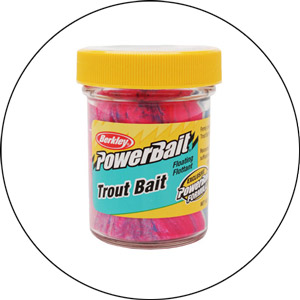
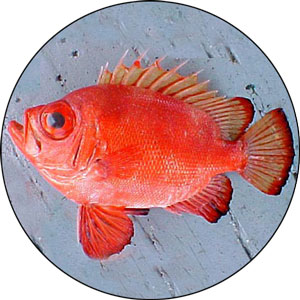
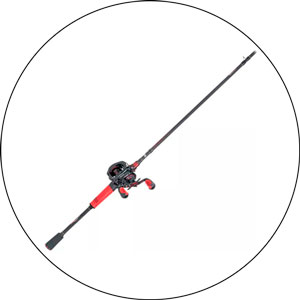
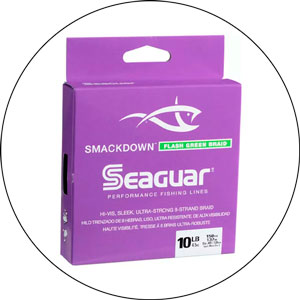
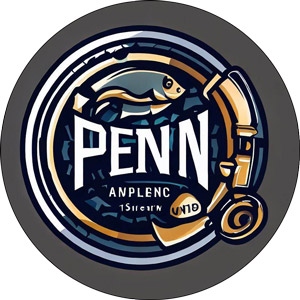
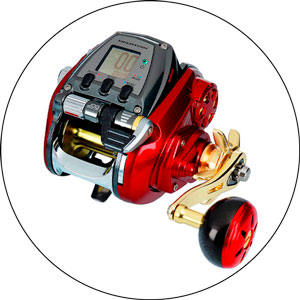
Longer fishing rods tend to cast further and offer more leverage when setting the hook or fighting a fish out of cover. However, shorter rods are more accurate when casting, which makes them great for picking apart a dock or a submerged tree. Overall, I find that a fishing rod between 6’8″ to 7’2″ in length is a good all-rounder.
When it comes to power, it’s important to choose a rod that is designed to throw lures within a given weight range. Going beyond this range can affect the performance of the rod, and impact how much backbone you have to fight a fish out of cover. For an all-around rod, I recommend going for medium power. However, if you fish in lakes with a lot of vegetation, a medium-heavy power rod is a great choice.
Action is also an important consideration when selecting a fishing rod. The action refers to how far down the rod will bend and how quickly it will return to its neutral position once the tension is relieved. For moving baits with treble hooks, such as crankbaits, a moderate action rod is ideal. It has a parabolic bend and takes longer to return to the neutral position. This gives the fish a chance to pick up the moving bait before it loads up on them fully, and it helps to fight the fish back to the boat if it lunges towards you.
However, if you’re looking for a more sensitive rod, an extra-fast rod with a quick snap back to its neutral position is ideal. It’s great for feeling even the slightest nibble on your bait. Keep in mind that the sensitivity of the rod will vary depending on the action, and it’s important to choose the right one for your fishing needs.
As a beginner in fishing, my wife and I are excited to start this new hobby together. I’ve been doing some research and after reading through this thread and talking to some friends who are experienced anglers, I think Ugly Stik rods would be a good option for our first rods. Since we will be fishing together, I’m planning on getting two rods, one for her and one for myself.
My question is, what would be the best length and power configuration for the two of us that would give us the biggest range of fish to catch? I was thinking of a 6ft rod with light power for her and a 7ft rod with medium power for myself.
I also noticed that Ugly Stik combos come with Shakespeare spinning reels, but some of my friends don’t like these reels. I’m willing to spend up to $200 for the setup of both rods, so roughly $50 for each spinning reel. Can you recommend some good spinning reel choices for the suggested rods and my price point?
We live in Central Arkansas and we’re looking to fish for largemouth bass, trout, and panfish in lakes and rivers to start. Thank you in advance for your help!
As a fishing enthusiast and someone who has been through the process of choosing a fishing rod for beginners, I can say that it can be a bit overwhelming with so many options available in the market. However, after doing some research and trying out a few, I have compiled a list of the best fishing rods for beginners:
Overall, these are all great options for beginners. When choosing a fishing rod, it is important to consider your own preferences, such as the type of fishing you will be doing and the size of fish you will be targeting.
Hey there, as someone who’s been fishing for a while now, I wanted to chime in on the discussion about rod choices. I totally agree that a medium-heavy rod can be a bit of overkill for most home fishing situations.
Sure, it’s got the power, but it lacks the sensitivity necessary for smaller fish and finesse presentations. Catching panfish with a heavy rod can take away all the fun because you can’t really feel the fish or see the rod bend. I’d recommend going for a medium rod instead, as it’s versatile enough to handle most of what your home lake has to offer.
I totally get the concern about musky, but let’s not worry about that just yet. They’re notoriously hard to catch and are called the fish of 10,000 casts for a reason. A medium rod will work just fine for smaller pike, and if you go for an Ugly Stik, it’s almost indestructible, so you don’t have to worry too much about the rod breaking. Plus, it’s always nice to have some extra rods and tackle living at the lake house.
When it comes to surf fishing, a 7′ rod is great for piers and jetties, but it might be a bit short for staying dry on the beach. I have to wade out to a sandbar to get my bait out far enough with my 7′ rod, and if I hook a really big fish, I worry about getting spooled with my 4000 series reel (though it hasn’t happened yet).
Hey there, I’m glad to see you’re interested in getting into fishing! As someone who’s been doing it for a while, I can tell you that a spinning rod is a great option, and there are tons of choices out there for every budget.
First things first, you’ll want to establish a budget. It doesn’t need to be huge – I’d suggest around $50-100 for a rod/reel combo, and then another $50-100 for lures, tools, and gear.
When it comes to the rod/reel combo, I recommend looking for a Medium or Medium-Light action, between 6′ and 7′ long. If you’re on the smaller side, a 6′ rod might be more comfortable, while a taller person might prefer a 7′ rod. The most beginner-friendly option is to go for a pre-packaged combo that includes both the rod and reel.
One thing I highly recommend is finding a local bait and tackle shop. They can help you cut through all the marketing jargon and find the gear that’s right for you. You might spend a little more than if you go online, but building a relationship with your local shop is valuable, and they’ll be able to offer advice and tips as you start to get more into the hobby.
Thanks for sharing your insights on getting started with fishing! I completely agree that starting at a local tackle shop is a great idea. You may pay a little more than online, but it can save you money in the long run by eliminating the guesswork and avoiding unnecessary purchases. Plus, they can give you helpful tips on what baits and lures to use and where to fish. A good tackle shop will get you set up and keep you coming back for more gear.
If possible, finding someone local to fish with and show you the ropes is even better. Many people get discouraged when they don’t catch fish right away, so having someone to guide you can make all the difference.
I definitely recommend starting with a spinning setup. If you’re not buying a pre-packaged rod and reel combo, it’s worth spending a little more on the reel than the rod. A cheap reel will be much more noticeable than a cheap rod. Plus, if you end up enjoying fishing, you can always upgrade your rod in the future while keeping your first reel.
For a first fishing rod, I suggest looking into the Ugly Stik. They may not be the best rods, but they’re tough and fairly inexpensive. Alternatively, the Shimano Sellus is a great option, with a medium or medium-light action that can handle a variety of fish.
I personally prefer the Shimano Sellus over the Ugly Stik GX2, as it’s more sensitive and that’s important to me. While durability is a big selling point of the Ugly Stik, if you know how to handle a rod, you’re unlikely to break it unless there’s a major defect.
As someone who loves fishing, I know how overwhelming it can be to choose the right fishing rod. But fear not, because there are a few important things to consider before making a purchase.
First and foremost, you need to think about what type of fishing you will be doing and your level of experience. If you’re a beginner, it’s best to opt for a model specifically designed for beginners. Typically, a spinning rod is the easiest to use.
You also need to take into consideration the poundage you need your rod to be able to handle. This will depend on the type of fish you plan on catching. If you’re aiming for larger fish like pike or salmon, you’ll need a rod that can handle their weight.
On the other hand, if you’re fishing for smaller fish like trout, a lighter rod will suffice. A smaller rod of about 4 ½ to 6 feet is ideal for smaller fish, while a larger one of more than 6 feet is better suited for larger fish and bait.
Make sure the rod fits comfortably in your hand, as it can make all the difference after a long day of fishing. You’ll want a comfortable grip and a good fit in your hand. Lastly, test how flexible the rod is by making a casting motion and observing how easily the end moves.
I’ve found that the Daiwa BG 2500-3000 is a great value for a reel. It’s hard to beat, and I used to be a huge fan of Penn Spinfisher and Slammer reels. You can usually find the Daiwa BG as a rod and reel combo too, which is a nice option.
Daiwa also has the Saltist reel, which is a step up from the BG, but I personally prefer the Back Bay version of that reel. It’s available with matching Back Bay rods, and I use that combo for just about everything except for kayak fishing. For that, I prefer shorter rods for easier handling while seated.
If you have a bigger budget, I’d recommend the Shimano Stradic CI4+ or the Daiwa Ballistic reels because they’re both incredibly nice and lightweight. I tend to use the Ballistic for saltwater fishing and the Stradic CI4+ for freshwater fishing. I know they’ve changed the name of the Stradic CI4+ to Vanford now, but I haven’t had a chance to test those out yet. I also haven’t tried the newer Ballistic MQ since the previous versions were already great and I didn’t feel the need to upgrade.
Choosing a rod is more subjective, so I suggest going to your local tackle shop and trying a few out. You’ll probably want a faster rod for this kind of fishing, with more graphite and less glass. Talk to the people behind the counter for some recommendations too.